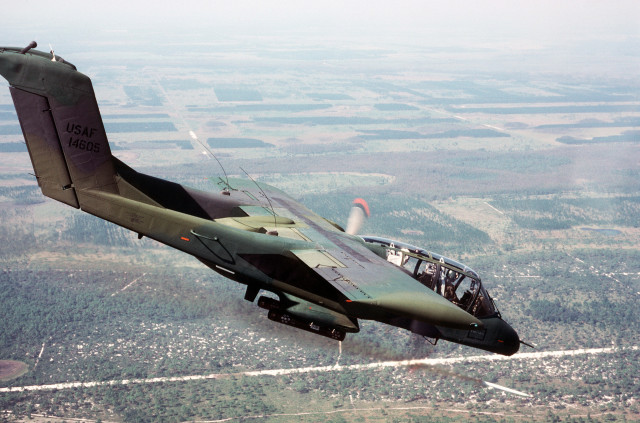
War is not a game – nor is it usually fought by retirees, especially those who have been in retirement for more than 30 years. These particular retirees however, are not people – they are aircraft
Two OV–10 Broncos, came out of ‘retirement” to support the Special Forces in Iraq. The planes were previously used in the Vietnam War and had proved to be “a flying and fighting do-all sport utility vehicle. It could loiter for hours, direct fire onto the enemy, pack paratroopers and cargo, or attack with its own weapons. Many think it was retired right when it could have become most useful and that it would have been the perfect light air support aircraft for Afghanistan.” (Tyler Rogoway)
The two Broncos that have just been on missions in Iraq and Syria, are thought to have come from NASA, which had originally snapped up the retired planes in order to carry out airborne tests, or perhaps from the State Department, which had sent Broncos to Columbia in a bid to crackdown on drug trafficking.
The OV-10 Bronco is an American turbo-prop, light attack and observation aircraft and is an aircraft particularly suited to counter – insurgency combat. These planes can take off at very short notice and can fly very low, so they could well have been used to aid the American Special Forces, the ‘Daily Beast’ reported. Further, the armaments fitted onto the plane were thought to include 2000 rounds of ammunition, which were probably utilized against the extremists, stopping them before they were able to evade the American and Iraqi ground troops.
A Central Command spokesman confirmed that the US military was testing the Broncos in Iraq and Syria to see whether they would be a viable replacement for the more expensive F-15s and F/A-18s used for most of the airstrikes in those countries. While there would be other considerations to take into account he said, a Bronco can operate for just $1,000 for every hour in the air while an F-15 can cost up to $40,000 per flight.
During the 1960’s the OV-10, was developed as a small, cheap attack plane and was much utilized in Vietnam, as it was able to take off from rough airfields near to the battlefront. Furthermore, repairs could be made with ordinary tools and no ground equipment was needed in order to start the engines – both most important considerations, particularly in times of war. The planes could carry two crew members and had a maximum speed of 281 kmh.
The OV-10 aircraft was first used in Vietnam in July 1965. The Bombing raid commanders (forward air controllers) used them to make observations, preparatory to their flying air raids during that conflict. These adaptable little planes were most successful. They performed a large number of missions for the US Navy, the Air Force as well as the Marine Corps. They were also put into service in a number of other countries. Eighty-one of the Broncos were lost during the Vietnam war, many of those losses being attributed to the aircraft being somewhat under-powered.
Subsequent to the war, the Navy, the Marines and the Air Force slowly retired their Broncos so that by the 1990’s there were few of them still in use in the American forces. However, many of the decommissioned planes were snapped up by other organisations.
It was thus more than 30 years after the Vietnam War that the Americans called on these planes yet again – this time to help fight in the conflicts in Afghanistan and Iraq. So recently, for three months, the two OV-10 Broncos, those small, Vietnam War-vintage, propeller-driven attack planes were involved in flying top cover for the ground troops battling with ISIS fighters in the Middle east. David Axe of the ‘Daily Beast’ writes that “the OV-10s’ deployment is one of the latest examples of a remarkable phenomenon. The United States… seized the opportunity afforded it by the aerial free-for-all over Iraq and Syria …to conduct live combat trials with new and upgraded warplanes, testing the aircraft in potentially deadly conditions before committing to expensive manufacturing programs.”
Time will tell whether or not our ‘Retiree’ OV-10 Broncos will once more grace the skies in numbers, or whether they have to make way for bigger, faster, technologically more advanced, modern aircraft.
Image By Service Depicted: Air ForceCamera Operator: TSGT BILL THOMPSON – ID:DFST8505744, Public Domain, https://commons.wikimedia.org/w/index.php?curid=884683

Δεν υπάρχουν σχόλια:
Δημοσίευση σχολίου